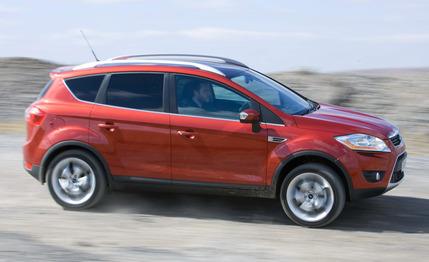
 Mini Test Road Test
Mini Test Road Test
With all of Ford’s woes in America, you may be surprised to learn that its European operation is on a roll. Ford of Europe is a profitable business that offers a range of cars that are generally acclaimed as the best-handling and most fun to drive of any from a big-volume automaker.
Soon after he arrived at Ford in 2006, CEO Alan Mulally recognized the strength of engineering and design residing at Ford of Europe and decreed that its work should become the standard for Ford’s small cars around the world. So the U.S. should get versions of the popular European models just as soon as Ford can get them modified, certified, and into production. It can’t happen a moment too soon: Detroit desperately needs those attractive and economical small cars.
The key is the new Fiesta supermini, which will go on sale in Europe this fall and in the U.S. a year or so later. In the meantime, Ford of Europe has plunged into the market for crossover SUVs, or soft-roaders, just as the tide is turning against urban 4x4s due to Europeans having to shell out the equivalent of about $9 for a gallon of gas.
We’re not sure that the name is a help. Kuga is how it sounds, a way of recycling Cougar, a Ford model designation that was more successful in the U.S. And the SUV sector is one area that Ford hasn’t been able to crack in Europe. The Explorer was too big, and the Escape (called the Maverick) had the wrong engines (no diesels) and wasn’t hip enough to match the compact sport-utes from the Japanese and Koreans.
The Kuga has the right ingredients to succeed. It is based on the platform, or rather the set of components, that makes the European Focus so good. It was launched only with a diesel engine—a 2.0-liter four-cylinder producing 134 horsepower—and is undeniably impressive in appearance.
It is not nearly as wild as the Iosis X concept car that preceded it, but the styling, inside and out, has a youthful flair. Design chief Martin Smith says that fashionable sports shoes were an inspiration.
At 174.9 inches (almost the same length as the Escape), the Kuga is bigger than any other model using the Focus underpinnings, and it is far taller—8.6 inches higher than a European Focus hatchback. It also has put on a lot of weight: It’s 500 pounds heavier than a diesel Focus.
So it is not surprising that it lacks the eagerness that one associates with European Fords. Zero to 62 mph arrives in 10.7 seconds, slow by today’s standards. Performance will be better with the promised 197-hp, 2.5-liter gasoline version, but hardly anyone in Europe will buy that model.
At least the Kuga handles and goes around corners crisply. A Haldex clutch system transfers the wagon from front-wheel drive to four-wheel drive when slippery road conditions arise. The system works smoothly and unobtrusively. Body control is good for a high-set car, and with its inevitably firm suspension, the ride is more comforting than you might expect.
Overall, though, it isn’t really a better drive than the Honda CR-V and several of the myriad soft-roaders that are available at the same or a lower price. The bling styling, with its deep trapezoidal grille making a face like a sad fish, will be the make-or-break point for the Kuga—and it just might be the wrong look for these introverted, cash-strapped, and environmentally conscious times.
The new Fiesta and the next Focus designed in Europe will be coming to the U.S. So, we would guess, will the Kuga, though not in this form. Expect it as the next-generation model sometime beyond 2012, fitted with the hybrid Escape drivetrain.